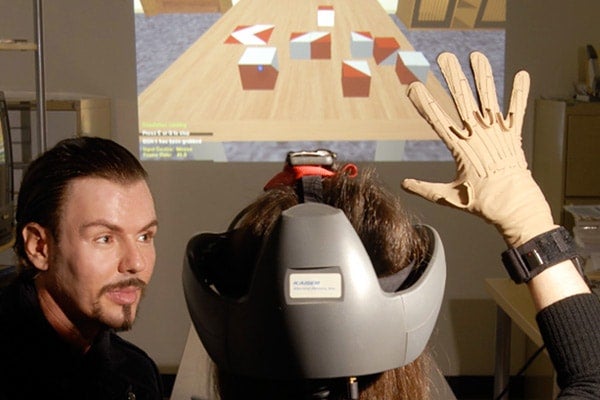
Virtual reality test for real-world impairments
Published: November 15, 2012
A virtual reality test being developed at University of Toronto Scarborough (UTSC) might do a better job than pencil-and-paper tests of predicting whether a cognitive impairment will have real-world consequences.
Developed by associate professor of psychology Konstantine Zakzanis and colleagues, the test uses a computer-game-like virtual world and asks volunteers to navigate their ways through tasks such as delivering packages or running errands around town.
“If we’re being asked to tell if people could do things like work, houseclean, and take care of their kids, we need to show that our tests predict performance in the real world,” says Zakzanis.
But standard tests don’t do that very well, he says. Tests that ask people to do things such as solve math problems, sort cards, remember names, or judge the relative positions of lines in visual two dimensional space, can detect cognitive impairments caused by circumscribed lesions following a stroke or head injury. However, they’re not very good at predicting who will be able to function in the real world and who won’t.
That’s a problem for cognitively impaired people who might be denied insurance benefits or workers compensation based on tests that are insensitive to demonstrating their impairment. It is akin to having a broken arm with no x-ray to prove it.
The virtual reality test is called the Multitasking in the City Task. Test-takers use a game controller to manoeuver their way through an artificial world. In one test, they are given 15 minutes to accomplish virtual tasks such as going to the bank, going shopping, and paying bills.
In another task, they have to deliver packages to offices given incomplete information – for instance, by reasoning that a caterer’s office is more likely to get a magazine about the food industry than is a lawyer’s. Yet another task requires the test-taker to watch moving assembly lines for defective products.
In a paper published in Applied Neuropsychology: Adult, the UTSC researchers tested 13 people who had suffered stroke or traumatic brain imagery, giving them a battery of standard tests as well as the virtual-reality test. They also gave them a questionnaire to determine how severely their cognitive deficits impacted their daily lives.
The standard tests didn’t predict how big an impact the cognitive deficits had in real life. But the virtual reality test did. Although the results are based on a small set of subjects, Zakzanis thinks that further work will confirm the usefulness of the new method.
The paper was co-authored by Diana Jovanovski, Zakzanis, Zachariah Campbell, Suzanne Erb and David Nussbaum, all of UTSC, and Lesley Ruttan of the Toronto Rehabilitation Institute. It is available here.



